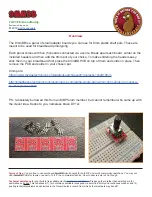
11-7
IM 253421-01E
Using the RS-232-C Interface (Optional)
11
Explanation
Mode Setting
For details, see section 11.1.
Handshaking
To use an RS-232-C interface to transfer data between this instrument and a
computer, it is necessary to use certain procedures by mutual agreement to ensure
the proper transfer of data. These procedures are called “handshaking”. Various
handshaking systems are available depending on the computer to be used; the same
handshaking system must be used for both computer and this instrument. This
instrument allows you to choose any handshaking method from the following eight
using the panel keys.
Data sending control
(Control method when sending data to computer)
Data receiving control
(Control method when receiving data from computer)
Software
handshake
Software
handshake
Hardware handshake
Hardware handshake
Sending stops
when X-off is
received, and
sending is
resumed when
X-on is
received.
Sending
stops when
CB (CTS) is
False, and
sending is
resumed
when CB is
True.
Sending
stops when
CC (DSR)
is False,and
sending is
resumed
when CC is
True.
No
handshake
X-off is sent
when received
data buffer
becomes 3/4-
full, and X-on
is sent when
received data
buffer
becomes 1/4-
full.
CD(DTR) is
set to False
when
received data
buffer
becomes 3/4-
full, and is set
to True when
received data
buffer
becomes 1/4-
full.
CA(RTS) is
set to False
when
received data
buffer
becomes 3/4-
full, and is set
to True when
received data
buffer
becomes 1/4-
full.
No
handshake
0
1
2
3
4
5
6
7
—
yes
yes
yes
—
—
—
—
—
—
—
—
yes
yes
—
—
—
—
—
—
—
—
yes
yes
yes
—
—
—
—
—
—
—
—
yes
—
—
—
—
—
—
—
—
yes
—
yes
—
yes
—
—
—
—
yes
—
yes
—
yes
yes
—
—
—
—
—
—
—
Mode selection no.
Handshaking method combinations (a circle indicates that the function is available)
Precautions Regarding Data Receiving Control
When handshaking is used to control received data, data may still be sent from the
computer even if the free space in the receive buffer drops below 16 bytes. In this
case, after the receive buffer becomes full, the excess data will be lost, whether
handshaking is in use or not. Data storage to the buffer will start again when there is
free space in the buffer.
64 bytes
Used
Free, 16 bytes
When handshaking is in use,reception
of data will stop when the free space in
the buffer drops to 16 bytes since data
cannot be passed to the main program
fast enough to keep up with the
transmission.
Used
Free, 48 bytes
After reception of data stops, data
continues to be passed to the internal
program. Reception of data starts
again when the free space in the buffer
inceases to 48 bytes.
Used
Whether handshaking is in use or not,
if the buffer becomes full, any
additional data received is no longer
stored and is lost.
11.3 Setting the Mode, Handshaking Method, Data Format and Baud Rate
















































